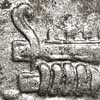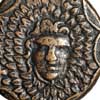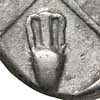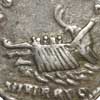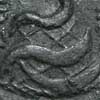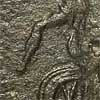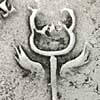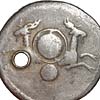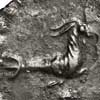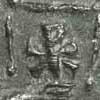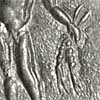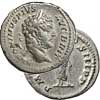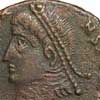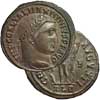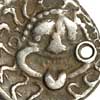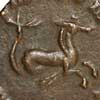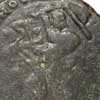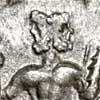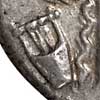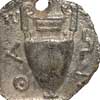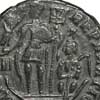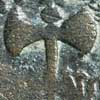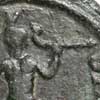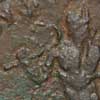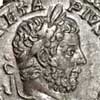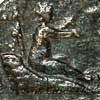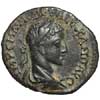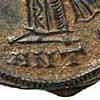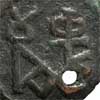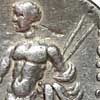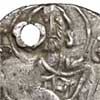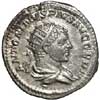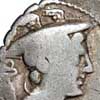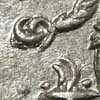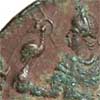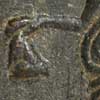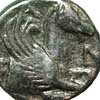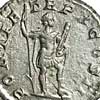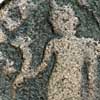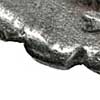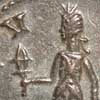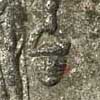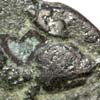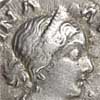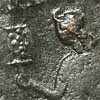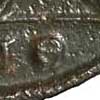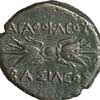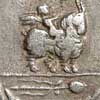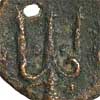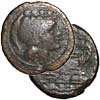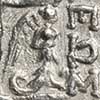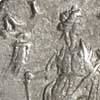| Home Page | Site Map | Useful Links | Email Me | Next Page |
| ---------- What I Like About Ancient Coins ---------- |
| Illustrated Ancient Coin Glossary |
This glossary explains the meaning of some of the ancient, technical, or hobbyist words used elsewhere on this site, and on other sites too. It includes a few words that relate to ancient history but not directly to coins. I'll add to it as more words come to mind. Words that show up as links are defined somewhere else in the list. If you would like a word added, please email me.
For more detail, I recommend a search on Forum's Numiswiki.
An ornamental curved extension of the stem post on the prow of a galley, sometimes with the addition of a carved animal's head in front. Galleys were often used on ancient coins to symbolise sea power or the successful completion of a journey. See also aplustre. There are several examples on my galley page.
An ornament, such as a decorative knob or a statue, on the pediment of a temple or other building. Some are at the apex, others are at the corners. The plural is "acroteria."
AE or Æ
An abbreviation used in coin descriptions meaning that the coin is of base metal or alloy, that is, not silver or gold; usually copper, brass or bronze. When used with a number, as in "AE23," "AE3" and so on, it indicates the size of the coin. For Greek coins, the number identifies the diameter of the coin in millimetres. For Roman coins, numbers from 1 to 4 indicate a size range. AE1 is over 25mm. AE2 is 21-25 mm. AE3 is 17-21 mm, and AE4 is less than 17mm. The abbreviation AE is derived from the Latin word aes. See also AR and AU.
A small leather cloak, or sometimes a shield, with the head or mask of Medusa (a gorgoneion) mounted on it. Shown sometimes by itself, sometimes worn or carried by Athena. For a look at the different ways it was shown on Roman and Greek coins, see my aegis page.
 Agathodaemon or Agathodaimon or Agathos Daimon
Agathodaemon or Agathodaimon or Agathos Daimon
In ancient Greece, a presiding spirit or genius of vineyards and grainfields, a bringer of good fortune. Represented on Roman Alexandrian coins as a serpent, often bearded, sometimes wearing the skhent, the double crown of Egypt. Alexandrian deities were often subjected to multiple syncretisations, so this is clearly not quite the same creature as the Greek Agathos Daimon.
aes
Brass, bronze or copper; base metal coinage. The first Italian base metal coinage was "aes rude," meaning rough or raw metal, and was just chunks of metal, as the name suggests. Later, there were heavy bars with simple designs known as "aes signatum," meaning marked or stamped metal. (An aes signatum is available to handle in the coin gallery of the British Museum in London.)
A cylindrical purple silk roll containing dust, held by the Byzantine emperors during ceremonies. It was intended to remind the emperor of his mortality.
A headband, often made of metal.
AR
An abbreviation used in coin descriptions meaning that the coin is of silver. It derives from "argentum," the Latin for silver. See also AE and AU.
Alpha
The first letter of the Greek alphabet, also used in ancient times as a numeral. Represented on ancient coins as an upper-case A. Used in the mintmarks of Roman coins to indicate officina 1. Also, of course, used as a letter in the legends of Greek and provincial Roman coins.
A tall vase, common in the ancient world, used for storage and transport of items such as grapes, wine, garum and oil. The neck was thinner than the body, and there were two looped handles on either side of the neck. Some were decorative. The simpler type, used for transporting goods, was made in the thousands and had a pointed base designed to be pushed into soft earth or sand. The word is often used wrongly in coin descriptions when the vessel shown is actually a volute krater.
The name given in modern times to a Roman coin thought to be twice the value of a denarius. Originally a silver coin. The amount of silver in the mix dropped drastically over the years, and later antoniniani were hard to tell from copper or bronze.
The hat worn by some Roman priests, with a spike fixed to the top.
The high upcurving decoration on the stern of a galley. Sometimes spelled "apluster" in the American fashion. "Aphlaston" is the Greek name. Characters with a naval connection were sometimes shown on coins holding a miniature aplustre. Galleys were often used on ancient coins to symbolise sea power or the successful completion of a journey. See also acrostolium. There are several examples on my galley page.
A Greek word for the white wool netting which covered the Omphalos, and was also worn by soothsayers. It was related to the casting nets used by hunters. It was made of raw wool which had been carded, but not spun or died. Paintings and copies of the Omphalos showed it with this netting. It can be seen on the example to the right, criss-crossing between the body of a snake.
The Russian name for a cubit, a measure of length which was standardised at 28 inches by Peter the Great. This name is often given to the measuring rod which is sometimes shown carried by Nemesis on Roman provincial coins.
Pronounced "ass." A copper Roman coin of low value, one-quarter of a sestertius. The plural is "asses". See also aes.
A sprinkler, one of the implements of the priestly colleges often shown grouped together on coins. There is an aspergillum second from left on this coin.
AU
An abbreviation used in coin descriptions meaning that the coin is of gold. It derives from "aurum," the Latin for gold. See also AE and AR. Au is also the international chemical symbol for gold.
A man whose job was to divine the future by watching the behaviour of birds. For example, predicting the success of a course of action by observing the flight of birds across the sky, using a lituus. The process is called "augury." The assemblage of priestly instruments on this coin includes a lituus on the right.
Augustus
In popular culture, the name "Caesar" is often used as a title for all Roman emperors. This indicates that from the Roman viewpoint, our popular culture is barbarous in nature. Julius' successor, Octavian, took the title "Augustus" and soon became known by that title. Thereafter, the reigning emperors were referred to as Augusti, and the title "Caesar" was used by intended heirs or subordinate partners. Only in outlying countries was the term "Caesar" retained for the emperor, which led to the use of titles such as "Tsar" and "Czar."
aureus
A gold coin of the late Roman republic and early Roman empire. Valued at 25 denarii. The plural is aurei.
A sacred stone. There were several in the ancient world, some of them very famous, such as the omphalos in Delphi, and the stone which personified the Syrian sun god Elagabal, which the emperor known as Elagabalus brought to Rome. Coins often showed them in their shrines, like the stone of Zeus Kasios on the right. Some, like the stone of Elagabal and the stone of Zeus Kasios, may have been meteorites. Others, like the omphalos of Delphi, were most likely carved.
barbarous
 To the ancient Greeks, this meant anything non-Hellenic. To the Romans, who took the word from the Greeks, it meant anything not Greek or Roman, or later, anything outside the Roman empire. In modern times, it means things associated with barbarians, people who have not developed a modern civilisation. But if a coin is referred to as "barbarous" it means that it was produced unofficially in an outlying area of the Roman empire, or even outside the border. ("Barbaric" usually means violent and cruel, and is not the best word to use here.) A "barbarous radiate" is a small bronze coin with a radiate portrait on the obverse. The word came from the Greeks, who reckoned that anyone who spoke a language other than theirs sounded as though they were just going "bar – bar – bar."
To the ancient Greeks, this meant anything non-Hellenic. To the Romans, who took the word from the Greeks, it meant anything not Greek or Roman, or later, anything outside the Roman empire. In modern times, it means things associated with barbarians, people who have not developed a modern civilisation. But if a coin is referred to as "barbarous" it means that it was produced unofficially in an outlying area of the Roman empire, or even outside the border. ("Barbaric" usually means violent and cruel, and is not the best word to use here.) A "barbarous radiate" is a small bronze coin with a radiate portrait on the obverse. The word came from the Greeks, who reckoned that anyone who spoke a language other than theirs sounded as though they were just going "bar – bar – bar."
Beta
The second letter of the Greek alphabet, also used in ancient times as a numeral. Represented on ancient coins as an upper-case B. Used in the mintmarks of Roman coins to indicate officina 2. Also, of course, used as a letter in the legends of Greek and provincial Roman coins.
A chariot drawn by two animals, usually horses, but sometimes shown on coins being pulled by other creatures such as elephants, goats or even lions or snakes for ceremonial or symbolic purposes. See also quadriga.
billon
An alloy of bronze (which consists of copper and tin) and silver. The silver content ranges from very high, so that the coin looks like silver, to very low, so that it looks like bronze. See also potin.
A coin which has been mis-struck in such a way that the reverse of the image of one side appears on the other side as an incuse. This occurs when a freshly struck coin sticks to one of the dies and impresses itself into the next blank flan instead of the die it is obstructing.
bronze
An alloy of copper and tin, more durable than either alone, and which when new has a shiny yellow appearance. Used for many coins, ancient and modern. The surface rapidly tones to an even brown, and can end up richly patinated. See also billon and potin.
The Latin word for the skull of an ox, sometimes used as a symbol on ancient coins. Sometimes shown decorated with garlands. The plural is "bucrania."
Referring to the eastern remnant of the Roman empire after the downfall of Rome and the western empire. Although "remnant" may not be the right word, as the empire and its descendants lasted for almost a millennium. Byzantine coins are reckoned from the reign of Anastasius I, starting in 491 CE, to the end of the Empire of Trebizond in 1461 CE. The inhabitants did not name themselves "Byzantine." They still thought themselves to be Roman, and usied the Greek word Romaion, a name which is often preferred in modern times.
An ornamental rod twined with two snakes, which face each other at the tip. The rod is often shown winged. It is an attribute of Mercury, the messenger of the gods, and symbolises trade and prosperity. It probably derives from the ribbon-draped willow wand traditionally carried by messengers. When carried by Hermes, the Greek equivalent of Mercury, it is called a kerykeion. It is sometimes confused with the staff of Aesculapius (Asklepios in Greek), which also has an entwined snake, but which has a quite separate medical symbolism. Shown on many ancient coins, either carried, used as a symbol, or as the main type. For some examples, see my pages on Mercury, Felicitas and the corn supply to Rome.
Caesar
The family name of the man who did not quite become an emperor of Rome, and also, later, the title used for an intended heir, or later still, a junior or subordinate emperor working as an obedient (in theory) partner of the reigning Augustus.
candelabrum-altar
See thymiaterion.
A mythical animal with the forepart of a goat and the tail of a fish. Sometimes shown in pairs, back-to-back, when the fishy tail is not clearly visible.
celator
In modern usage, an engraver of coin dies. "Caelator" is a real Latin word, but its use with this meaning (and a modern American spelling) is a recent invention. In ancient times it referred to "caelatura," which seems to have meant some sort of fancy metal-work not connected with coinage.
A race of mythical creatures with the body of a horse and the upper body and head of a man, connected where the horse's neck would be.
A rustic lyre, made from a tortoise shell. It was supposed to have been invented by the god Hermes and given by him to Apollo. The larger professional lyre is a kithara.
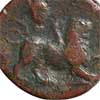 Chimaera or Chimæra or Chimaira or Chimera
Chimaera or Chimæra or Chimaira or Chimera
Chimaera (sometimes "the Chimaera," but actually Chimaera was its name) was a mythical creature. According to Homer, it had the body and head of a lion, the tail of a snake, and a goat's head growing from its back. According to Hesiod it had three heads; a lion in front, a dragon at the back and a goat in the middle. It was supposed to be able to breathe fire. The Homeric type appears on several coins. This creature was killed by the legendary hero Bellerophon, riding the winged horse Pegasus.
Chi-Rho
A monogram made up of the Greek letters Chi and Rho. See Christogram
A simple ancient Greek cloak, probably formed by draping a square of wool diagonally. Typically worn by a traveller, hence worn by Hermes and Mercury. A flimsy cloak usually called a chlamys is often the only clothing of heroically nude figures such as Sol, Mars or Genius on Roman coins, shown draped over the shoulders or off one arm, enhancing rather than concealing the nude form. For more detail, see this chlamys footnote.
A monogram made up of the Greek letters Chi and Rho, which look to us like X and P. These letters make up the start of the name of Christ in Greek. Sometimes called a Chi-Rho. Often shown on coins being engraved on a shield, or on a labarum.
A small column or pillar, often with an inscription, sometimes shown supporting some object on Roman coins.
conjoined
Two heads in profile next to each other, so that both profiles can be seen. See jugate.
contorniate
A type of Roman medallion with a depressed border inside the rim.
On ancient coins, this means wheat or barley, not maize. Many coin descriptions, especially older ones, were written using "corn" to mean the local grain crop, in the British fashion. Maize was not a food crop in the ancient world. There are some examples on my page on the corn supply to Rome.
A horn which in legend contained endless good things, usually shown with fruits overflowing or being poured out. The word was originally two words, cornu copiæ, meaning "horn of plenty," so although the standard English word is "cornucopia," it is often seen in coin descriptions as "cornucopiae." Often carried by personifications on ancient coins. There are many examples on my horn of plenty page.
A mythical sea creature with the head and forelimbs of a ram, and a sinuous fishy rear end. Scarce on coins, and perhaps only appears on this antoninianus of Gallienus. See also hippocamp.
cubit
A measure of length. See arshin.
Wearing a cuirass, the top section of a suit of armour. Used to describe the bust of an emperor. Often used together with draped, as "draped and cuirassed," in which case only a fraction of the armour might be visible.
A curule chair was a folding camp-stool with curved legs, symbolic of and used by certain senior Roman magistrates, particularly the curule aedile. Consuls were also entitled to such a chair.
The fourth letter of the Greek alphabet, also used in ancient times as a numeral. Represented on ancient coins as a triangle, Δ, often with decorative serifs. Used in the mintmarks of Roman coins to indicate officina 4. Also, of course, used as a letter in the legends of Greek and provincial Roman coins.
A silver Roman coin, produced during the Republic and the first three centuries of the Empire. Sixteen times the value of an as, four times the value of a sestertius. The plural is "denarii".
An ornate headband, tied at the back. Late Roman coins commonly show the emperor wearing a diadem of pearls, or sometimes rosettes and laurel leaves, to indicate royalty. In coin descriptions, a person wearing one is said to be "diademed".
In connection with coins, this means the stamp which placed the impression or design on a blank coin flan. Two dies were required, one for each side. The flan was placed on the lower die, which usually had the obverse image; the upper die, with the reverse image, was placed on top of it, and was struck one or more times with a hammer. Not to be confused with Julius Caesar's famous saying when he crossed the Rubicon, "Alea jacta est," usually translated as "The die is cast." That die is the singular of dice.
The sixth letter of the archaic Greek alphabet, still used in ancient times as a numeral even though it was no longer part of the written alphabet. Represented on ancient coins either as a capital S or as a similar character with the lower curve elongated and straightened. Used in the mintmarks of Roman coins to indicate officina 6. Very often referred to in coin descriptions as a Stigma; this is inaccurate.
Having two columns. On Roman coins, they usually belonged to a shrine or temple. The word describes the number of columns shown on the coin, not the number the actual temple might have had. See also tetrastyle and hexastyle.
Wearing clothing other than armour. Used to describe the bust of an emperor. Wearing clothing without armour would be "draped"; wearing something such as a cloak over armour would be called "draped and cuirassed".
A Roman coin, usually made of brass or copper. Twice the value of an as. On dupondii, the head of the emperor was usually radiate, and this can be recognised even when the coin is quite worn to distinguish it from an as. The plural is "dupondii."
Eta
The eighth letter of the archaic Greek alphabet (but only the seventh letter in the ancient written language - see Digamma). Also used as a numeral. Represented on ancient coins as a capital H. Used in the mintmarks of Roman coins to indicate officina 8. Also, of course, used as a letter in the legends of Greek and provincial Roman coins.
The fifth letter of the Greek alphabet, also used in ancient times as a numeral. Represented on ancient coins either as a straight-backed capital E, or a lunate Є. Used in the mintmarks of Roman coins to indicate officina 5. Also used to indicate the value of a Byzantine 5-nummus coin. Also, of course, used as a letter in the legends of Greek and provincial Roman coins.
A space at the bottom of the reverse of a coin. Often, a line is drawn to separate this space from the rest of the coin. Mint marks are often found here on Roman bronze coins. Sometimes part of the legend is placed here, for example on some Roman silver coins.
A bundle of sticks, particularly the bundle containing an axe which was carried by lictors, who preceded Roman magistrates when they walked through the streets. It symbolised their authority.
When used of coins, this means the flat undecorated area, usually between the legend and the central design or type. Sometimes, mint marks or other control marks are placed here.
flan
The blank from which a coin is struck. Flans were made and prepared in different ways in different places and times. Commonly they would be a weighed and perhaps smoothed disk of metal, which would be heated just before the coin was struck.
A bag, bellows, money-purse or scrotum. Used to mean a type of late Roman coin from the time of Diocletian, perhaps because it was worth enough smaller coins to be a purse-full in itself. Also used for certain large Byzantine or Romaion coins which had a value of 40 nummi.
An ancient counterfeit or unofficial coin with a base metal core and a precious metal surface. They are often very patchy, and sometimes only a bronze core remains to be seen.
The third letter of the Greek alphabet, also used in ancient times as a numeral. Represented on ancient coins as an inverted upper-case L, Γ. Used in the mintmarks of Roman coins to indicate officina 3. Also, of course, used as a letter in the legends of Greek and provincial Roman coins.
Head, or face, or mask of a gorgon, particularly of the gorgon Medusa. Used on coins and amulets and the Aegis. For some examples, see my pages on the story of Medusa and ancient coins showing the Aegis.
A mythical creature having the body of a lion and the head and wings of an eagle.
A narrow-necked jug, one of the implements of the priestly colleges often shown grouped together on coins. There is a guttus on this coin, the second object from the right.
An agricultural implement with a hooked extension, used like a sickle or scythe, used by Saturn and shown with him on Republican coins and a coin of Gallienus. Also, when adapted as a hand weapon, the type of sword used by Perseus to kill Medusa. There are some examples on my page about the story of Medusa.
Having six columns. On Roman coins, they usually belonged to a temple. The word describes the number of columns shown on the coin, not the number the actual temple might have had. See also distyle and tetrastyle .
A mythical sea creature with the head and forelimbs of a horse, and a sinuous fishy rear end. Some have wings, and some do not. See also criocamp.
A many-headed water monster that lived in Lake Lernea, which Hercules killed as one of his twelve labours.
A design which is below the level of the coin's surface rather than standing out above it, which would be much more usual. Sometimes done on purpose, sometimes by accident, as in a brockage. Many Greek coins have the reverse design inside a larger incuse square.
Iota
The tenth letter of the archaic Greek alphabet (but only the ninth letter in the ancient written language - see Digamma). Also used as a numeral. Represented on ancient coins as a capital I. Used in the mintmarks of Roman coins to indicate officina 10, and in combination with other letters to indicate higher officina numbers. Also, of course, used as a letter in the legends of Greek and provincial Roman coins.
Two heads joined at the back and facing in opposite directions, like the god Janus.
Two heads in profile next to each other, so that both profiles can be seen. Sometimes called conjoined.
In ancient Greek culture, a basket with a flared top, used to carry corn and also other light materials. Sometimes referred to as a "bushel measure." Sometimes copied as a miniature in metal or ceramics as a symbolic item, or to hold votive offerings. Sometimes shown on Roman coins worn as symbolic headgear by deities or personifications, and when it is, coin descriptions often incorrectly call it a polos or a modius. There is a kalathos and some examples of modii on my page about the corn supply to Rome.
An ancient Greek drinking cup, with two large handles that rose above the rim. Shown on coins by itself, or being carried by characters associated with carousing, such as satyrs.
kerykeion
The staff of Hermes. See caduceus for details.
A lyre, a larger professional version of the simple folk instrument called a chelys. "Kithara" is the Greek word; the Latin version is "cithara."
An attendant on the goddess Cybele, usually one of a group. The plural is "Korybantes." They wore crested helmets and armour, and worshipped the goddess with dancing to the beat of a drum. The example on the right appears to be naked to the waist.
A large ceramic or bronze container used by the ancient Greeks for mixing wine and water, ready to drink. There are four different types, of varying shape. The one most often seen on ancient Greek coins is a volute krater. In coin descriptions, this vessel is often incorrectly identified as an amphora.
A standard with a Christogram, often shown on coins of the family of Constantine the Great.
A double-headed axe, sometimes carried by Zeus or Jupiter, sometimes used as a symbol.
A shepherd's throwing stick, sometimes referred to as a boomerang, used for bringing down small creatures such as rabbits. The word is also sometimes used to refer to a shepherd's crook, which in latin is a pedum, but that confuses the two separate uses of such a thing, perhaps because it is sometimes hard to tell which one is being shown. But that is not always so. The first example shown here might indeed be either based on its appearance. The second example is clearly a throwing stick.
Wearing a laurel wreath.
A large bowl sometimes placed on a tripod.
When used of coins, this means the writing on the coin, usually excluding the mintmarks and any special marks in the field. Typically, the legend runs around the outside edge of the coin, though there are exceptions, especially with non-Roman coins.
A liknon was a shallow high-backed basket, used to throw up threshed corn to separate the grain from the chaff. This object is sometimes called a winnowing fan — in fact, this device is the first meaning of the word "fan" given in the Oxford English Dictionary.
Pronounced "lee-mays". Latin for a limit or boundary, and in relation to coins it means the boundaries of the empire. Limes coins, coins of the limes, and limes falsa all mean base metal versions of silver coins, usually found near the north and east boundaries of the Roman empire and assumed to have been made there. Some are cast, some appear to have been struck, and many are so well engraved that there is a view that they were made with official dies. This is strongly disputed by other respected experts, who believe they are contemporary fakes.
A curved wand used by an augur. The augur would use the lituus to mark out the divisions of the sky in which he would make his observations. Sometimes shown on Roman coins together with other implements of the priestly colleges such as a jug or guttus, a knife, a sprinkler or aspergillum, a patera, an apex, a bucranium, and a simpulum. The plural is "litui."
lunate
Curved in the shape of a crescent moon. Used, for example, to describe a lunate Epsilon, Є.
Literally, the hand of God. On coins, it refers to the depiction of a hand reaching down from above on late Roman bronze coins, often holding a halo above the head of the figure on the coin.
Literally a napkin or tablecloth, used to dry the hands when they were washed after a meal. The sort of cloth dropped by the emperor or presiding magistrate to signal the start of a race. Later, an attribute of the consuls. On late Roman bronze coins, sometimes shown gripped by the emperor on the obverse. The origin of the modern word "map," which now means something rather different.
A sequence of letters or symbols that show which mint, and sometimes also which officina, produced a coin. Often to be found in the exergue or the field of Roman coins.
A basket or container used as a measure for corn. Often shown on Roman imperial coins as an indication of the corn supply, and sometimes worn as a symbolic hat by personifications to which the corn supply was relevant. The Greek equivalent is a kalathos. Many coin descriptions incorrectly identify kalathoi as modii. For some examples, see my page on the corn supply to Rome.
Two or more letters combined into a single design. An obvious example on Roman coins is the christogram found on late Roman bronze coins. Many Greek and Roman republican coins also used monograms.
mule
A coin with the obverse of one type and the reverse of another. These coins are made in official mints but are clearly mistakes caused by using the wrong dies. Often they are discovered because the obverse is of an emperor and the reverse is of his empress, or of a previous emperor.
mural crown
A crown or headdress in the shape of a city wall. A personage wearing such a crown is said to be turreted.
The Greek for a cane or wand. On coins, it refers to the stems of giant fennel used to construct the thyrsos of Dionysos. Some coins show the god carrying two narthex wands.
A fawn's skin. Originally worn by hunters, later by worshippers of Dionysos and by Pan and fauns. The example shown here is carried over Pan's left arm - you can see two hooves dangling from it.
Having a nimbus or halo surrounding the head. Often seen on Byzantine coins, rare before that.
A small Byzantine copper coin, rarely seen but used as the base value for larger copper coins. These multiples had a large letter on the reverse which showed their value in nummi in the Greek style. Those seen most often are: M for 40 nummi (see "follis"), K for 20 nummi, I for 10 nummi and Є for 5 nummi.
The front, or "heads" side, of a coin. On Roman Imperial coins, usually shows the head of the Emperor or a relative. On Roman Republican coins, can show a variety of themes. On Greek coins, it's sometimes not even clear which side of the coin we are referring to. The other side is called the reverse.
officina
A workshop within a mint. Most mints had several workshops and it seems that it was sometimes useful to be clear about who had produced which coins. Therefore, mint marks or marks in the field often included this information.
A small jug with a spout and one handle, used for pouring wine into drinking cups.
The Omphalos was a sacred stone sited near the prophetic chamber of the oracle of Delphi. The word means "navel" in Greek, indicating its position in the centre of the Hellenic world. There were several copies, and some other stones are sometimes given this name, but the Delphi stone is the original and the one which is usually meant by the term. Apollo, the patron deity of the Delphic oracle, is often shown seated on the Omphalos. It was usually shown on coins as covered by a white wool netting, the agrenon, though this is worn to invisibility on many examples. See also baetyl.
orichalc or orichalcum
A brass alloy which was used to make such Roman coins as sestertii and dupondii. An earlier Greek meaning is "mountain copper."
The sacred statue of Pallas Athene, also called Minerva, carrying shield and spear, which was held in safe keeping by the Vestal Virgins. Sometimes shown carried on Roman coins.
A Roman military cloak worn over armour for warmth. Sometimes shown on coins just as a fold over the shoulder of the armour. Heavier than a chlamys.
A short triangular sword or long dagger. Often carried on Roman coins, sheathed, hilt outwards, by the emperor or by Virtus.
A shallow dish from which a sacrifice or libation could be poured, often onto an altar. Many Roman coin reverse types show figures holding a patera, which symbolised piety and religious intent. Some coins showed creatures with religious connections, such as snakes and peacocks, being fed from them. The nearest Greek equivalent was the phiale.
On coins, the triangular space between the roof of a temple and the lintel or ceiling line, usually containing some form of decoration. See also acroterium.
A shepherd's crook. Examples on coins are sometimes labelled as a lagobalon, a rabbit hunter's throwing stick. The example shown here might be either based on its appearance.
A mythical winged horse, supposedly born fully formed from the severed neck of the Gorgon Medusa when she was killed by Perseus. Later ridden by the hero Bellerophon. Appeared on many Greek and Roman coins, as shown on my Pegasus page. Called Pegasos by the Greeks and Pegasus by the Romans.
An ornate drinking vessel consisting of a drinking horn decorated with a model of the forepart of the mythical winged horse Pegasos. Appears on coins of Skepsis. In real life, the horn would be larger in proportion than shown on this coin.
A broad-brimmed Greek sun-hat, typically worn by travellers and so worn by Hermes and Mercury. The petasos of Hermes and Mercury is usually shown winged, representing great speed as much as flight. "Petasos" is the Greek word; "Petasus" is Latin.
In ancient Greek culture, a shallow dish, metal or ceramic, from which a libation of wine could be poured. It had a raised dimple in the centre into which a steadying finger could fit from below and a thumb could rest on top, and so might be called a "phiale mesomphalos." The nearest Roman equivalent, but lacking the dimple, was the patera; but many Roman coins showed a phiale mesomphalos rather than a patera, as can be seen by the placement of the thumb or finger.
Pronounced "fee-niks". A mythical bird that at the end of its life was said to make a nest of cinnamon twigs, set light to it and burn up, then rise renewed from the flames. Often used as a symbol of eternity or immortality. A radiate phoenix on a globe is seen on several Roman coins.
A felt cap, more or less conical, worn by freed Roman slaves, and known as the cap of freedom; a similar cap is worn by the French Marianne and appears on the so-called Mercury dime, with the same meaning, though in those cases it had a turned-over top and was called a Phrygian cap. Held on Roman coins by Libertas, the personification of freedom. It was also associated with the Dioscuri, the heavenly twins, and when two pilei were shown on a coin, that is what they symbolised.
polos
Cylindrical headwear worn by some eastern deities. The name is often inaccurately applied to a kalathos.
pomerium
The formal and religious boundary of the city of ancient Rome, marked out by white stones. It did not include all of the famous seven hills. Tradition held that it was the line marked out with a plough by Romulus when he founded the city. The pomerium was extended by Claudius and perhaps also by others.
An alloy of copper, tin and lead, of varying proportions but higher in lead than most ancient bronze coins, which are essentially copper and tin. The lead content gives a smoother look and feel to the surface of such coins and sometimes allows a red patina to form. It was used in Gaul to make Celtic coins, and in Alexandria to make later Roman tetradrachms. See also billon.
A Greek pottery vessel designed for pouring.
A frontal view of an animal. On coins, typically the forepart of an animal (or mythical creature) cut off at the middle.
The front of a sailing vessel, for example a galley. Sometimes shown apart from the rest of the vessel, sometimes in miniature with a figure standing on it, often resting a foot on it. There are several examples on my galley page.
pschent
The double crown of Egypt. An alternative spelling of the word skhent.
Punic
Carthaginian. The word derives from the Greek for Phoenician. Carthage was originally a Phoenician colony, whose name meant "New Town" in the Phoenician tongue.
A copper coin worth a quarter of an as. This was really small change. The plural is "quadrantes."
A chariot drawn by four creatures, usually horses, but sometimes shown on coins being pulled by other creatures for ceremonial purposes. Ben Hur raced a fast quadriga in the film. See also biga.
A half-denarius or half-aureus coin. The plural is "quinarii."
Wearing a crown of spiky rays, representing the rays of the sun. Early Roman emperors were shown radiate on some coins; later ones, on most of their coins. The Roman sun-god Sol and the Greek sun-god Helios were always shown radiate – see my page on Sol for examples.
When used of Roman coins, it means an issue that replicates an older coin, perhaps with a few minor changes. Sometimes this was done to ensure that revered predecessors stayed circulating on the coinage when old coins were recalled for a change in the money system. Sometimes it was to honour a particular ancestor.
The back, or "tails" side, of a coin. On Roman Imperial coins, usually shows propaganda of some kind. On Roman Republican coins, usually shows a theme which glorifies an ancestor of the moneyer. On Greek coins, it's sometimes not even clear which side of the coin we are referring to. The other side is called the obverse.
In coin descriptions, this usually refers to a spear held point downwards, which is supposed to be a less aggressive stance than when it is held with the point upwards.
A drinking vessel in the shape of a horn. Originally, made from a horn, and with a hole at the end to drink through. Often ornamented with animal's heads. See also Pegasosrhyton.
Romaion
The Greek word for Roman, referring to the eastern remnant of the Roman empire after the downfall of Rome and the western empire. This adjective is often preferred to Byzantine.
rostral column
A column with the foreparts of galleys mounted on it, celebrating a naval victory.
A wreath or crown consisting of miniaturised foreparts of galleys, awarded by the Senate to leaders of naval victories.
The ram or beak on the prow of a galley, often with two or three prongs. Although at or under the waterline in real life, so as to sink rammed ships, often shown above water level on coins. The word also came to mean the speaker's platform in the Roman forum, which had the beaks of galleys mounted on it.
A bag, sometimes worn over the hair and head of females on Greek coins. It could be bound with cord to form attractive shapes.
A staff or rod which might have ornamental ends, carried as a symbol of royalty, or by some deities. Sceptres were sometimes long, often taller than the person carrying them; and sometimes short, and held almost playfully. Some emperors were shown carrying a sceptre tipped with an eagle. ("Scepter" is the American spelling.)
A coin struck in the Roman Republic and the early Imperial period, with a value of half an as. The plural is "semisses".
Having a notched edge. Typical of some Roman republican denarii and the flans of some Seleucid bronze coins. The modern adjective is "serrated;" "denarius serratus" is Latin for a serrated denarius.
A large Roman brass coin. Four times the value of an as. The plural is "sestertii".
A small ladle used in religious ceremonies. Sometimes shown on Roman coins together with other implements of the priestly colleges such as a jug, a knife, a sprinkler, a patera, an apex, a bucranium, and an augur's lituus. The plural is "simpuli".
A metallic jangling rattle, carried by the goddess Isis, along with her situla, and used by her priests to draw attention to the various stages of their ceremonies. The plural is "sistra." See my page on Isis for examples.
A water carrier in the form of a large jug or a bucket. A ceremonial situla, sometimes with an appearance of basket-work, is carried by the goddess Isis, along with her sistrum. See my page on Isis for examples.
The double crown of Egypt, combining the crowns of the older separate kingdoms of the upper Nile and the lower Nile. The illustration on the right is not very clear; it shows the shkent on the head of the serpent Agathodaemon. An alternative spelling of the same word is pschent.
A deep drinking mug with two loop handles at its sides. The handles may be horizontal or vertical in orientation, or one of each in a so-called "owl" or "glaux" skyphos. The handes are relatively plain and do not loop high and ornately like those of a kantharos.
The plural is skyphoi.
A decorated hair band which forms a U-shape around back of the head. Also used to refer to a full hair band when the rear part is the dominant feature. (Definition from Numiswiki)
A mythical creature. In Greek myth she was unique, a creature called Sphinx who had the body of a winged lion and a human head. Other mythologies have multiple sphinxes, including the Egyptian, where they were usually temple guardians; and of course there is the famous Egyptian sphinx at Giza with the body of a recumbent lion and the head of the Pharaoh Khafra.
A casting sprue is a projection on the edge of a coin, showing that the flan was cast rather than shaped in any other way. It is the place where the blank coin was broken away from its attachment before the pattern was struck onto it. Some coins were legitimately made this way. On coins that were not, it is a sign of a fake.
A pole or spear which acted as the emblem of a cohort within a Roman legion. The pole was decorated with disks, wreaths and battle honours, and a hand was often fixed on the top. Not the same device as the eagle fixed to a pole which was the emblem of the whole legion.
Star-shaped, or radiating from a central point. Sometimes the actual pattern is some way away from the ideal. The example shown is a double stellate pattern.
A Greek word meaning a crown or coronet, shown worn by some females on Greek and Roman coins. Sometimes referred to as a diadem, even though it does not resemble the ornate type of headband normally called by that name.
Stigma
A name often wrongly used for the Digamma or Wau, the sixth letter of the archaic Greek alphabet, which was used as a numeral in ancient times, including on ancient coins. "Stigma" actually represents the medieval (manuscript) and modern (15th-19th century printing) ligature of two letters, S + T, and has nothing to do with the archaic Digamma; the name came to be used in that way purely because of a coincidence in the shape of the characters concerned. For more detail, see this stigma footnote.
A set of pipes made from hollow reeds of different lengths tied together. Carried by the god Pan, who supposedly invented them, and sometimes called "pan pipes".
Literally a ribbon, the word also means a traditional Greek headband. "Tainia" is the Greek word and "taenia" is the Latin version. It can be distinguished from a diadem by not having ties at the back.
A square tablet which could be marked with various information such as a watchword. It is often stated that the tablet carried on Roman coins by Liberalitas is a tessera marked with points which represent gifts such as money and corn. However, it is clear on early medallions showing liberalitas scenes that this is actually a counting board, a board with circular depressions holding coins which allowed a standard sum to be quickly and easily measured and then poured into the recipient's toga.
tetradrachm
A coin valued at four drachms. What constituted a drachm varied with place and time, and an ancient tetradrachm can be a large, heavy silver coin or a smaller potin one.
Having four columns. On Roman coins, they usually belonged to a temple. The word describes the number of columns shown on the coin, not the number the actual temple might have had. See also distyle and hexastyle .
The ninth letter of the archaic Greek alphabet (but only the eighth letter in the ancient written language - see Digamma). Also used as a numeral. Represented on ancient coins as a capital O with a central line, Θ. Used in the mintmarks of Roman coins to indicate officina 9. Also, of course, used as a letter in the legends of Greek and provincial Roman coins.
A representation of a bolt of lightning, having a central core from which spiky or decorative lines emerged to either side. Often shown with wings. Usually shown by itself; carried by Zeus (Greek) or Jupiter (Roman); carried by his daughter Athena (Greek) or Minerva (Roman); or grasped by an eagle, Zeus' sacred bird.
Often called a candelabrum-altar, this was a stand which held a bowl or dish at about waist height. The bowl probably held hot coals or charcoal so that incense dropped on it would smoke attractively. "Thymiaterion" is the original Greek word and "thymiaterium" is the Latin equivalent. On Roman coins, various characters are shown dropping incense onto a thymiaterium as an act of piety.
A staff traditionally made from a stem of the giant fennel plant (sometimes called a ferula), wound with ivy and sometimes with ribbons, and tipped with a pine cone. Carried by Dionysos, and representing his spirit. "Thyrsos" is the Greek word and "thyrsus" is the Latin version.
Wearing a toga. Some Roman coins show the emperor togate, sometimes with the toga pulled up over the head in a religious scene.
When used in coin descriptions, this means something held at an angle, usually across the body, rather than straight up and down. For example, a spear, a long sceptre, or a long caduceus.
Literally, having three teeth. Used to mean a spear with three prongs, the traditional weapon of Neptune (Roman) and Poseidon (Greek).
A bronze coin of the Roman republic, valued at four unciae, or one-third of an as. The plural is "trientes."
Literally, having three feet. Normally applied to a three-legged altar, or a stand for a large bowl usually called a lebes, a combination that coin descriptions often call a tripod-lebes. A tripod-seat on its own is associated with Apollo, because the priestess of his shrine at Delphi sat on a tripod to give oracular pronouncements.
A mythical creature with a human body and the tail of a dolphin or fish. Triton proper was a Greek god, the messenger of the sea, the son of Poseidon and Amphitrite. The name can also refer to lesser creatures with the same form, who could be either male or female. The female Triton shown here is a variant with wings.
The weapons and armour of a defeated enemy, attached to a pole. Shown on Roman coins carried by Mars and sometimes by Victory, or standing with one or a pair of captives bound at its foot. May be called a tropaion on descriptions of coins from Greek-speaking areas.
Wearing as a headdress a crown representing a city wall, sometimes with towers and turrets of different heights. Sometimes referred to as a mural crown.
A simple drum composed of a membrane stretched over a circular support, like a tambourine without the jangles. It is shown on coins carried by, or accompanying, Cybele and the Magna Mater. There are examples on my Cybele page.
type
When used of Roman coins, this means the main design on the reverse, usually inside the legend and above the exergue.
A bronze coin of the Roman republic, valued at one twelfth of an as. The plural is "unciae."
unofficial
When used of coins, it means that the coin was not made in an official mint. It might be a contemporary fake, or a coin made for local use in the absence of official small change (sometimes called "money of necessity"). Examples include the so-called barbarous radiates, and most fourrée coins.
The military standard of a subdivision of a Roman legion.
vota
Vows. On coins, usually for the safety of the emperor. Late Roman bronze coins showed vows both given and renewed for five years or multiples of ten years.
Wau
See Digamma.
The seventh letter of the archaic Greek alphabet (but only the sixth letter in the ancient written language - see Digamma). Also used as a numeral. Represented on ancient coins as a capital Z. Used in the mintmarks of Roman coins to indicate officina 7. Also, of course, used as a letter in the legends of Greek and provincial Roman coins.
This page contains blank space at the end to place each reference correctly at the top of the screen when it is accessed.
| The content of this page was last updated on 2 September 2017. |
| Home Page | Site Map | Useful Links | Email Me | Next Page |
